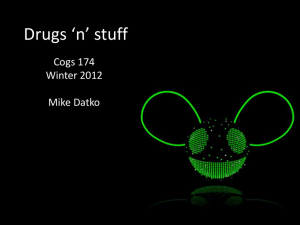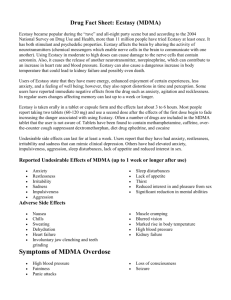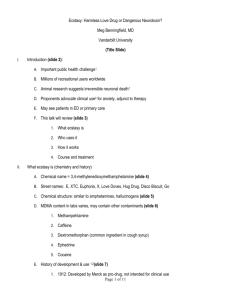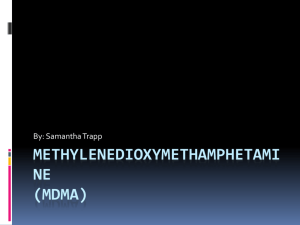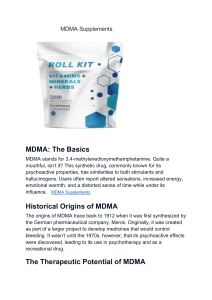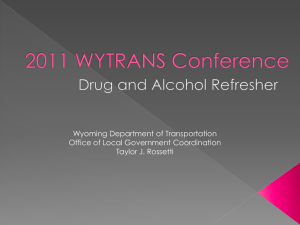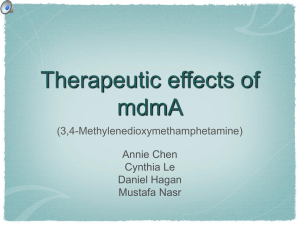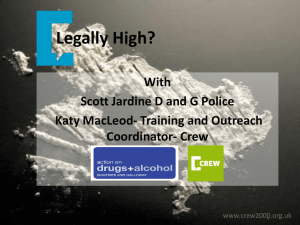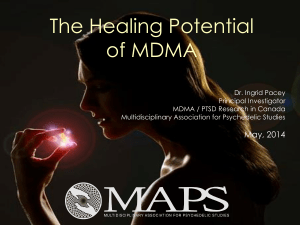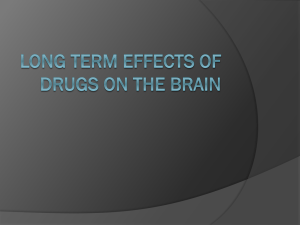Ecstasy - UCSD Cognitive Science
advertisement
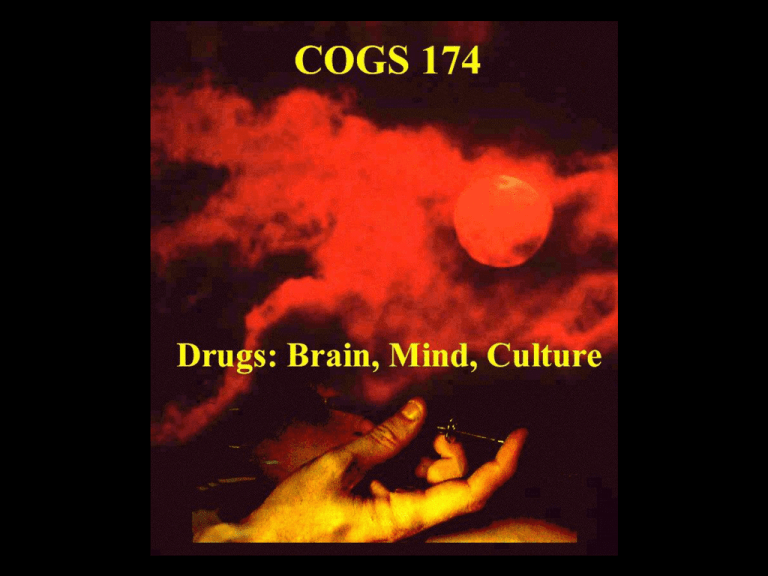
Ecstasy/MDMA Ecstasy/MDMA Overview • MDMA = 3,4-methylene dioxy-Nmethyl amphetamine (Schedule 1) • Shares properties of amphetamines and hallucinogens • Associated with electronic music dance parties (“raves”) • May have psychotherapeutic value (entactogens, empathogens) • Associated with 5-HT neurotoxicity • “Ecstasy” often adulterated (amphetamine, ketamine, PCP, caffeine), may consist of 0 - 100% MDMA History • Synthesized, patented by Merck (1912, 1914) • Studied as appetite suppressant but never marketed (50s and 60s) • Researched by Army intelligence as potential truth serum (50s) • Limited recreational use (60s) • Psychotherapeutic use (mid-late 70s): called “penicillin for the soul” • Use leaks out to expanding recreational useacquires name of Ecstasy (early 80s) • DEA places MDMA in Schedule I (1985-88) • Use spreads to Europe, becomes part of raves, spreads back to U.S. (late 80s) Hallucinogenic Psychotherapy Redux “an easily controlled altered state of consciousness with emotional and sensual overtones, and with little hallucinatory effect” UC Berkeley biochemist/toxicologist Alexander Shulgin, self-report after synthesizing and selfadministering 120mg MDMA, 1978 Combination of • Stimulant effects • Mild hallucinogen-like effects • More unique emotional effects MDMA Psychotherapy • 1970s research appeared successful, but poorly controlled • Advantages over hallucinogenic therapy: – – – – – – shorter-acting more introspection greater intimacy/trust reduced anxiety/depression less altered perception more stable body image and ego • Current overseas research suggests decreased drug use, other psychiatric improvements Use of Ecstasy among 8th,10th and 12th graders 12 10 8 8th 10th 12th 6 4 2 0 95 96 97 98 99 '00 '02 '05 Perceived Harmfulness of Obtaining Ecstasy Reported by 12th Graders 80 70 60 50 % who think MDMA is harmful 40 30 20 10 0 '00 '01 '02 '03 '04 '05 Methods of Ingestion • • • • Orally Snorted (Powder) Smoked Injected • Effect lasts 3-6 hrs • Average dose is 1-2 tablets (60-120 mg) • • • • 20 to 40 minutes 5 to 10 minutes 20 to 30 seconds 10 to 20 seconds Acute Effects (cont) Mood (euphoria) Alertness (sympathomimetic) Heart rate, blood pressure, body temperature Restlessness, locomotion Sensory intensity Fatigue, need for sleep (insomnia) Appetite Empathy, communication, talkativeness (empathogenesis) Feelings of sensuality, affection (entactogenesis) Self-consciousness, fear, embarrassment, defensiveness Nystagmus, jaw-clenching, muscle tension (need for pacifiers) Visual distortion, dizziness, headache, nausea, vomiting (more likely at higher doses) Neurotoxicity Raves Raves (GHB, Meth, K, Rohypnol, NO, LSD) • Setting – Club, Warehouse, Outdoors – Psychedelic/Techno Décor – Short notice • “Tools” – Pacifier/lollipops – Masks – Inhalants (e.g. Vicks) – Glowsticks Raves (cont) • Music and Dance – DJed electronica – Usually fast (average 120 bpm) and high energy • Philosophy – “Technoshamanism” – altering consciousness through technology – PLUR (Peace, Love, Unity, and Respect) Ecstasy experience “The drug removes all your neuroses. It takes away the fear of response. There is an overwhelming sense of peace, you are at peace with the world. You feel open, clear, tender. I can’t imagine that anyone is angry under its influence, or selfish or mean or defensive. You have lots of insight into yourself, real insight, which you hold on to after the experience is gone” Behavioral Effects • Positive: mental stimulation, emotional warmth, empathy towards others, general sense of wellbeing, decreased anxiety • Negative/Undesirable: anxiety, agitation, recklessness, nausea, chills, sweating, muscle cramping, blurred vision, jaw clenching, dehydration, high blood pressure, heart failure, kidney failure, arrhythmia, loss of consciousness, seizures, hyperthermia, hyponatremia (low sodium levels) Ecstasy-Viagra • Clubgoers call a combination of the two drugs "sextasy" heightens sexual experience. • the two drugs are a dangerous mix. • can cause heart problems and open the door to sexually transmitted diseases. Pharmacokinetics • Dose: ~ 80-160mg (500mg – fatal) • Route: Usually oral (high bioavailability from GI tract) • Onset: 30-60 minutes • Peak: ~1 hour • Duration: 3-12 hours Pharmacodynamics • Indirect agonist for – 5-HT – DA and NE (less than 5-HT) – different from hallucinogens • Mechanisms – Block reuptake (5x amph) – Reverse reuptake – Others like AMPH? Neurobiological Effects 1) MDMA increases oxytocin levels, which may strengthen the therapeutic effects; 2) MDMA increases ventromedial prefrontal activity and decreases amygdala activity, which may improve emotional regulation and decrease avoidance, and 3) MDMA increases norepinephrine release and circulating cortisol levels, which may facilitate emotional engagement and enhance extinction of learned fear associations. DSM-IV Dependence Criteria by Pill Use 1-99 pills (n=387) 100-499 pills (n=178) 500+ pills (n=69) 100 p<.0001 p=.0014 p<.0001 80 p<.0001 p<.0001 60 p<.0001 40 p<.0001 20 0 Tolerance Withdrawal Takes substance in larger amounts or over longer period Can't cut down or control use Much time spent using/recovering from use Important activities given up for substance Substance used despite knowing it caused physical or psychological harm rCBF differences between MDMA and placebo. Upper row: MDMA-induced increases in rCBF. a = ventromedial frontal cortex (including orbitofrontal and ventral anterior cingulate cortex), b = cerebellum, c = inferior temporal cortex, d = occipital cortex. Lower row: MDMA-induced decreases in rCBF. e = superior temporal cortex, f = insula, g = Thalamus, h = pre-/paracentral cortex, k = left amygdala Neurotoxicity • Effect: destruction of 5-HT axons • Suspected consequences – Depression – Personality changes (e.g. irritability) – Cognitive impairment • Verbal memory in particular Neurotoxicity (cont) • Possible mechanisms/factors – Main candidate: Oxidative stress • Exhausted energy sources • Free radical metabolites – Cofactor: Body temperature • Indices – Tissue staining – 5-HT and metabolite levels – Reuptake transporter binding THE END 5-HT Axons Frontal MDMA MDMA Methodological Issues • Animal studies – Route of administration – Dose/Frequency – Drug content – Species differences • Human studies – Discussed in reader article Use Statistics • In 1998, 3.4 million Americans age 12+ (1.5%) had used Ecstasy at least once • Heaviest number users in ages 18 - 25 (1.4 million, i.e. 5%) • From 1999 - 2000, use increased among 8th, 10th, and 12th graders but decreased from 2000-2005 • African-American students used less than white or Hispanic students in 2000 Raves (cont) • Ecstasy acute risks – – – – Dehydration Heat Stroke Organ failure Adulterants • “Herbal Ecstasy” – Natural stimulant (e.g. ephedrine) – Similar acute risks – Placebo psychoactive effects Ecstasy “Hangover” • Effects – Depression – Memory impairment – Difficulty concentrating • Possible causes – – – – Neurotoxicity Acute decrease in 5-HT levels Concurrent drug use Weekend contrast
